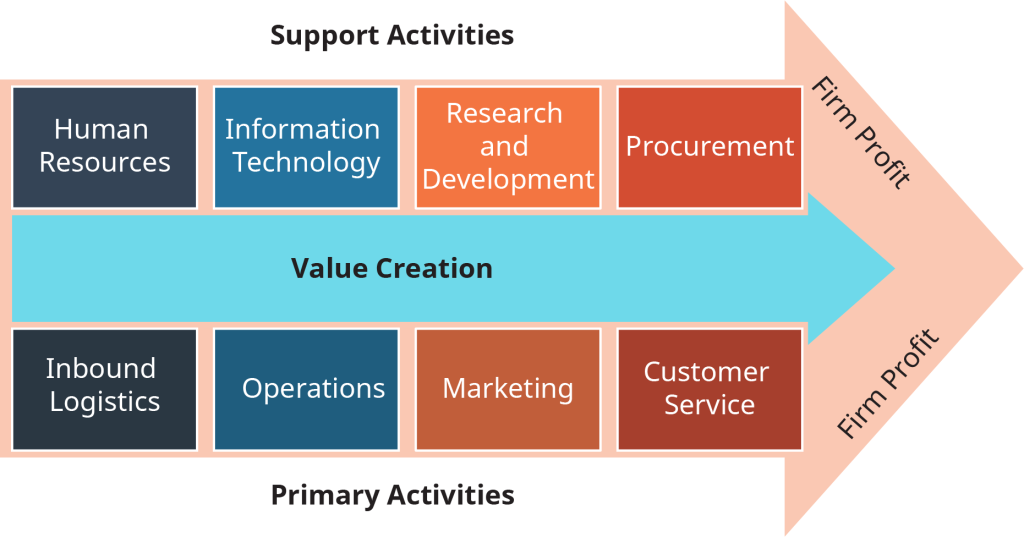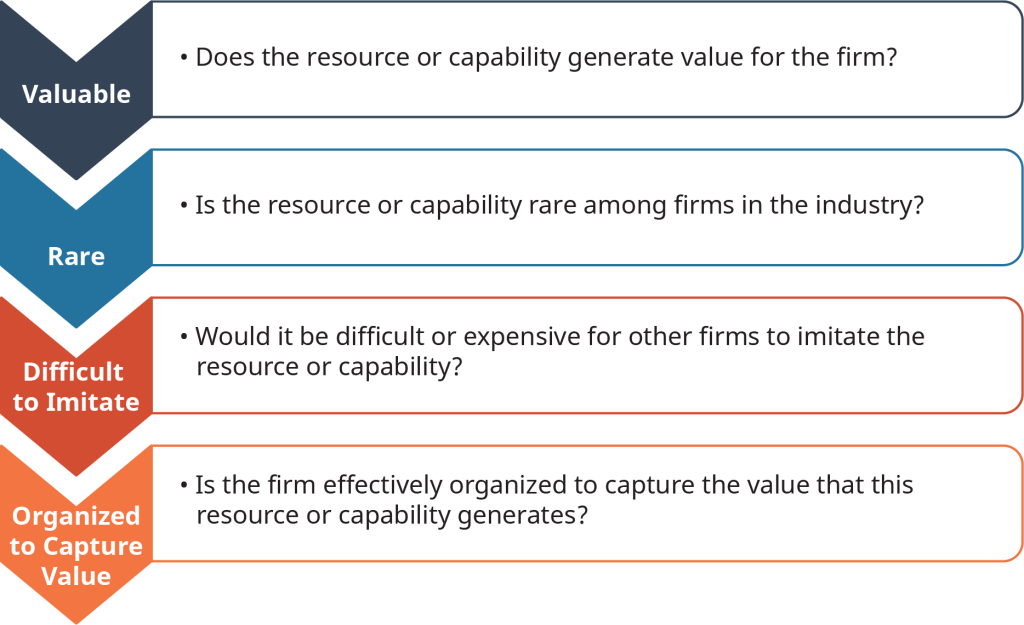5.5 The Internal Environment
The internal environment consists of members of the firm itself, investors in the firm, and the assets a firm has. Employees and managers are good examples; they are firm members who have skills and knowledge that are valuable assets to their firms. Evaluating a firm’s internal environment is not just a matter of counting heads, however. Successful firms have a wide range of resources and capabilities that they can use to maintain their success and grow into new ventures. A thorough analysis of a firm’s internal situation provides a manager with an understanding of the resources available to pursue new initiatives, innovate, and plan for future success.
Resources and Capabilities
A firm’s resources and capacities are the unique skills and assets it possesses. Resources are things a firm has to work with, such as equipment, facilities, raw materials, employees, and cash. Capabilities are things a firm can do, such as deliver good customer service or develop innovative products to create value. Both are the building blocks of a firm’s plans and activities, and both are required if a firm is going to compete successfully against its rivals. Firms use their resources and leverage their capabilities to create products and services that have some advantage over competitors’ products. For example, a firm might offer its customers a product with higher quality, better features, or lower prices. Not all resources and capabilities are equally helpful in creating success, though. Internal analysis identifies exactly which assets bring the most value to the firm.
The Value Chain
Before examining the role of resources and capabilities in firm success, let’s take a look at the importance of how a firm uses those factors in its operations. A firm’s value chain is the progression of activities it undertakes to create a product or service that consumers will pay for. A firm should be adding value at each of the chain of steps it follows to create its product. The goal is for the firm to add enough value so that its customers will believe that the product is worth buying for a price that is higher than the costs the firm incurs in making it. As an example, Figure 5.5 illustrates a hypothetical value chain for some of Walmart’s activities.

Image © Rice University & OpenStax, CC BY 4.0
In this example, note that value increases from left to right as Walmart performs more activities. If it adds enough value through its efforts, it will profit when it finally sells its services to customers. By working with product suppliers (procurement), getting those products to store locations efficiently (inbound logistics), and automatically keeping track of sales and inventory (information technology), Walmart is able to offer its customers a wide variety of products in one store at low prices, a service customers value. Primary activities, the ones across the bottom half of the diagram, are the actions a firm takes to directly provide a product or service to customers. Support activities, the ones across the top of the diagram, are actions required to sustain the firm that are not directly part of product or service creation.
Using Resources and Capabilities to Build an Advantage over Rivals
A firm’s resources and capabilities are not just a list of equipment and things it can do. Instead, resources and capabilities are the distinctive assets and activities that separate firms from each other. Firms that can amass critical resources and develop superior capabilities will succeed in competition over rivals in their industry. Strategists evaluate firm resources and capabilities to determine if they are sufficiently special to help the firm succeed in a competitive industry.
Using VRIO
The analytical tool used to assess resources and capabilities is called VRIO. As usual, this is an acronym developed to remind managers of the questions to ask when evaluating their firms’ resources and capabilities. The four questions of VRIO, which focus on value, rarity, imitation, and organization, are illustrated in Figure 5.6.

© Rice University & OpenStax, CC BY 4.0
If each question can be answered with a “yes,” then the resource or capability being evaluated can be the source of a competitive advantage for the firm. An example will help you better understand the VRIO process.
Imagine that you are a top manager for Starbucks and you want to understand why you are able to be successful against rivals in the coffee industry. You make a list of some of Starbucks’ resources and capabilities and use VRIO to determine which ones are key to your success. These are shown in Table 5.2.
| Starbucks’ Resources and Capabilities | |
|---|---|
| Resources | Capabilities |
| Brand name | Making quality coffee drinks |
| Thousands of locations worldwide | Delivering excellent customer service |
| Cash | Training excellent staff |
| Loyal customers | Paying above-average wages |
| Well-trained employees | Retaining quality employees |
You look at your list and decide to pick a few of the entries to evaluate with VRIO (Table 5.3):
| Evaluating Starbucks’ VRIO | |||||
|---|---|---|---|---|---|
| Resource/Capability | Is it valuable? | Is it rare? | Is it difficult to imitate? | Is Starbucks organized to capture its value? | Can it be a basis for competitive advantage? |
| Brand name | Yes | Yes | Yes | Yes | Yes |
| Delivering excellent customer service | Yes | Yes | Yes | Yes | Yes |
| Thousands of locations worldwide | Yes | No | No | Yes | No |
According to the evaluation above, Starbucks’ brand helps it compete and succeed against rivals, as does its excellent customer service. However, simply having a lot of locations globally isn’t enough to beat rivals—McDonald’s and Subway also have thousands of worldwide locations, and both serve coffee. Starbucks succeeds against them because of their brand and customer service.
Case: Uber, Lyft, and the Self-Driving Car
Although the ride-sharing industry is still relatively new, it has seen explosive growth, and its two main rivals, Uber and Lyft, are looking for ways to increase their capacity to serve riders. Both firms, and rivals like them, operate in basically the same way. A person needing a ride uses a smartphone app to alert a nearby person with a car of their location. The driver, usually an independent contractor for the service (meaning they are just a person with a car that has signed up to provide rides in exchange for a portion of the fare the customer pays), picks up the customer and drives them to their destination.
The popularity of ride-sharing services has soared, and both companies are constantly recruiting more drivers. However, both companies have also explored alternatives to independent drivers: self-driving cars. Uber and Lyft have taken different paths to develop this capability. Uber has worked to internally develop its own software technology and self-driving car technology, while Lyft has focused on software interfaces that can accommodate other companies’ self-driving cars (Bensinger, 2017). Lyft’s partnerships with firms such as Google and GM that are already developing self-driving cars has put it ahead of Uber in the race to get driverless vehicles into its ride-sharing network, and it was able to test self-driving cars in Boston by partnering with NuTonomy in 2017 (Edelstein, 2017). Lyft offered a demonstration to journalists at the Consumer Electronics Show in Las Vegas in 2018, offering rides in self-driving cars developed by Aptiv (O’Kane, 2018). Uber had been testing similar technology in Pittsburgh but suspended its self-driving car program after a fatal pedestrian accident in Arizona (Korosec, 2018).
Critical Thinking Questions
- What resource or capability challenges have Uber and Lyft faced because their fast company growth?
- What PESTEL factors do you think are contributing to the popularity of ride-sharing services?
- What industry challenges (think of Porter’s Five Forces) does the use of self-driving cars address?
Principles of Management – Chapter 8.5 by Open Stax is licensed under a Creative Commons Attribution 4.0 International License, unless otherwise noted.

